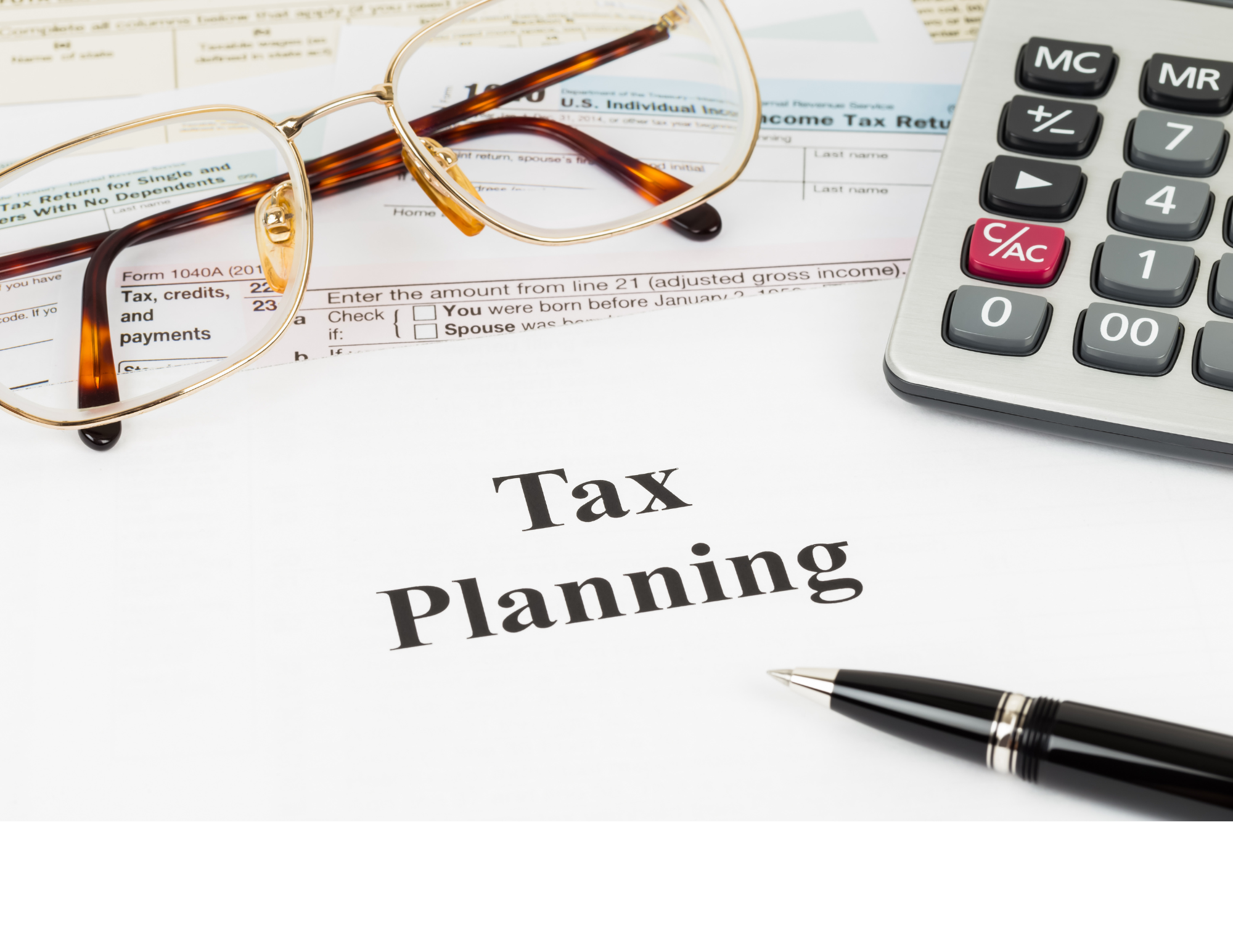Introduction
In today’s complex financial landscape, effective personal tax planning has become an essential skill for individuals seeking to maximize their wealth and minimize their tax burden. As tax laws continue to evolve and economic uncertainties persist, the importance of developing a comprehensive tax strategy cannot be overstated. This article will delve into the intricacies of personal tax planning, providing you with a roadmap to navigate the often-confusing world of taxes and empowering you to make informed decisions that can significantly impact your financial well-being.
Personal tax planning is more than just filing your annual tax return; it’s a year-round process that involves careful consideration of your income, investments, deductions, and long-term financial goals. By implementing effective tax planning strategies, you can potentially reduce your taxable income, increase your tax deductions and credits, and ultimately keep more of your hard-earned money in your pocket.
The benefits of proactive tax planning extend far beyond simply lowering your tax bill. A well-executed tax strategy can help you:
- Maximize retirement savings
- Optimize investment returns
- Fund education expenses more efficiently
- Support charitable causes while reaping tax benefits
- Protect your wealth for future generations
According to a study by the Government Accountability Office, 86% of taxpayers could benefit from better tax planning, yet many fail to take advantage of available strategies. This oversight can result in thousands of dollars in unnecessary taxes paid each year.
As we explore the various aspects of personal tax planning, it’s important to remember that tax laws are subject to change, and what works for one individual may not be the best approach for another. Always consult with a qualified tax professional before implementing any new tax strategies to ensure they align with your specific financial situation and goals.
In the following sections, we’ll break down the key components of effective tax planning, discuss strategies for different life stages, and provide actionable tips to help you take control of your tax situation. Whether you’re a young professional just starting your career or a retiree looking to preserve your wealth, this comprehensive guide will equip you with the knowledge and tools needed to make informed decisions about your taxes and financial future.
Understanding the Basics of Personal Tax Planning

What is Personal Tax Planning?
Personal tax planning is a strategic approach to managing your financial affairs with the goal of minimizing your tax liability while staying compliant with tax laws. It involves analyzing your current financial situation, anticipating future income and expenses, and making informed decisions about how to structure your finances to achieve the most favorable tax outcome.
Unlike tax preparation, which focuses on accurately reporting past financial activities, tax planning is a proactive process that looks ahead to identify opportunities for tax savings. It requires a comprehensive understanding of tax laws, financial products, and how various financial decisions can impact your overall tax picture.
Key components of personal tax planning include:
- Income management
- Deduction optimization
- Credit utilization
- Investment strategies
- Retirement planning
- Estate planning
Effective tax planning is crucial for several reasons:
- Maximizing after-tax income: By reducing your tax liability, you keep more of your earnings.
- Enhancing financial stability: Proper planning can help you avoid unexpected tax bills and penalties.
- Supporting long-term financial goals: Tax-efficient strategies can accelerate wealth accumulation and preservation.
- Compliance: Staying informed about tax laws helps ensure you remain in good standing with tax authorities.
As of 2024, the IRS reported that it collected nearly $2.6 trillion in individual income taxes during the fiscal year 2023. This data is consistent with the broader financial trends and projections for federal tax revenue in 2024 and beyond.
When Should You Start Tax Planning?
The ideal time to start tax planning is as early as possible, preferably at the beginning of each tax year. However, it’s never too late to start implementing tax-saving strategies. Tax planning should be an ongoing process, with regular check-ins and adjustments throughout the year.
Here’s a general timeline for effective tax planning:
| Time of Year | Tax Planning Activities |
|---|---|
| January-March | Review previous year’s return, set financial goals, adjust withholdings |
| April-June | Implement investment strategies, consider mid-year tax projections |
| July-September | Evaluate year-to-date income and expenses, start planning for year-end moves |
| October-December | Execute year-end tax-saving strategies, make final charitable contributions |
While year-end tax planning is crucial for maximizing deductions and credits before the tax year closes, ongoing planning throughout the year allows for more flexibility and can yield better results. For example, a study by Vanguard found that tax-smart investing strategies implemented consistently throughout the year can add up to 0.75% in additional after-tax returns annually.
Case Study: The Power of Early Planning
Consider two individuals with identical incomes of $100,000:
- Sarah starts tax planning in January, identifies that she’ll be close to the next tax bracket, and increases her 401(k) contributions to reduce her taxable income. She also spreads her charitable donations throughout the year to take advantage of employer matching programs.
- John waits until December to think about taxes. He realizes he’s in a higher tax bracket than expected but has limited time to make significant changes to his tax situation.
Result: Sarah’s proactive approach allows her to reduce her taxable income by $10,000 through increased retirement contributions and optimized charitable giving. This moves her to a lower tax bracket and saves her approximately $2,200 in taxes. John, on the other hand, misses out on these opportunities and pays the full amount.
By understanding the basics of personal tax planning and committing to an ongoing process, you can set yourself up for significant tax savings and improved financial outcomes. In the next sections, we’ll delve deeper into specific strategies and considerations for effective tax planning at various life stages.
Assessing Your Current Tax Situation
Before implementing any tax planning strategies, it’s crucial to have a clear understanding of your current tax situation. This assessment will serve as the foundation for developing an effective tax plan tailored to your specific circumstances.
Evaluating Your Taxable Income
Taxable income is the portion of your gross income that is subject to taxation after accounting for allowable deductions and exemptions. Understanding the different types of income and how they are taxed is essential for effective tax planning.
Types of Taxable Income:
- Earned Income: Wages, salaries, bonuses, and self-employment income
- Investment Income: Dividends, interest, and capital gains
- Passive Income: Rental income and certain business activities
- Other Income: Alimony, gambling winnings, and retirement account distributions
To calculate your taxable income, start with your gross income and subtract any above-the-line deductions to arrive at your Adjusted Gross Income (AGI). From there, subtract either the standard deduction or your itemized deductions to determine your taxable income.
Example Calculation:
Gross Income: $80,000
Above-the-line Deductions: -$5,000
————————————-
Adjusted Gross Income (AGI): $75,000
Standard Deduction: -$12,550 (2021 single filer)
————————————-
Taxable Income: $62,450
It’s important to note that different types of income may be taxed at different rates. For instance, long-term capital gains are typically taxed at lower rates than ordinary income. Understanding these distinctions can help you make more informed decisions about income timing and investment strategies.
For a comprehensive guide on calculating taxable income, visit the IRS website.
Identifying Your Tax Bracket
Your tax bracket is determined by your taxable income and filing status. The U.S. uses a progressive tax system, meaning that as your income increases, you’re subject to higher tax rates on additional income.
2025 Tax Brackets for Single Filers:
| Tax Rate | Taxable Income Range |
|---|---|
| 10% | $0 to $11,600 |
| 12% | $11,600 to $47,150 |
| 22% | $47,150 to $100,525 |
| 24% | $100,525 to $191,950 |
| 32% | $191,950 to $243,725 |
| 35% | $243,725 to $609,350 |
| 37% | Over $609,350 |
It’s crucial to understand that being in a higher tax bracket doesn’t mean all your income is taxed at that rate. Only the income within each bracket is taxed at the corresponding rate.
Implications of Tax Brackets:
- Marginal Tax Rate: This is the rate at which your next dollar of income will be taxed.
- Effective Tax Rate: This is the average rate you pay on your total taxable income.
- Tax Planning Opportunities: Understanding your bracket can help you make decisions about income timing, deductions, and credits.
For example, if you’re near the top of your current bracket, you might consider deferring income or increasing deductions to avoid moving into a higher bracket.
Reviewing Past Tax Returns
Analyzing your previous years’ tax returns can provide valuable insights for future tax planning. Look for patterns, missed opportunities, and areas where you might have overpaid.
Key Areas to Review:
- Income Fluctuations: Understand why your income may have changed and how it affected your tax liability.
- Deductions and Credits: Identify any deductions or credits you may have missed or underutilized.
- Investment Performance: Evaluate the tax efficiency of your investment strategy.
- Life Changes: Note any significant events (marriage, children, home purchase) that impacted your taxes.
Case Study: The Value of Return Review
John, a self-employed consultant, reviewed his past three years of tax returns with his CPA. They discovered that John had been missing out on the home office deduction, which he was eligible for. By amending his previous returns and implementing this deduction going forward, John was able to reduce his taxable income by $5,000 annually, resulting in approximately $1,100 in tax savings each year.
By thoroughly assessing your current tax situation, including evaluating your taxable income, identifying your tax bracket, and reviewing past returns, you’ll be better equipped to make informed decisions about your tax planning strategies. This foundational knowledge will serve as a springboard for implementing more advanced tax planning techniques.
Key Components of Effective Tax Planning

Effective tax planning involves several interconnected components that, when optimized together, can significantly reduce your overall tax burden. Let’s explore these key components in detail.
Income Management
Strategic income management is a cornerstone of effective tax planning. The goal is to control when and how you receive income to minimize your tax liability.
Strategies for Income Management:
- Income Deferral: Postponing income to a future tax year can be beneficial if you expect to be in a lower tax bracket in the future. This can be achieved through:
- Delaying year-end bonuses
- Deferring sales of appreciated assets
- Maximizing contributions to tax-deferred retirement accounts
- Income Acceleration: In some cases, it may be advantageous to accelerate income into the current tax year, especially if you anticipate being in a higher tax bracket in the future.
- Income Splitting: This involves shifting income to family members in lower tax brackets, often through family businesses or trusts.
- Harvesting Capital Gains or Losses: Strategically realizing capital gains or losses can help manage your overall tax liability.
According to a study by Kitces.com, effective income management strategies can potentially save retirees up to 30% on their lifetime tax bill.
Deduction Optimization
Maximizing your deductions is crucial for reducing your taxable income. There are two main types of deductions: standard and itemized.
Standard vs. Itemized Deductions:
The standard deduction is a fixed amount that reduces your taxable income, while itemized deductions are specific expenses that can be deducted individually. For 2024, the standard deduction amounts are:
- Single filers: $13,850
- Married filing jointly: $27,700
- Head of household: $20,800
Strategies for Deduction Optimization:
- Bunching Deductions: This involves grouping deductible expenses into a single tax year to exceed the standard deduction threshold.
- Charitable Giving: Donations to qualified organizations can be deducted if you itemize. Consider using donor-advised funds for more strategic giving.
- Medical Expenses: If your medical expenses exceed 7.5% of your AGI, you can deduct the amount over this threshold.
- State and Local Taxes (SALT): You can deduct up to $10,000 in combined state and local income, sales, and property taxes.
- Mortgage Interest: Interest on home mortgages up to $750,000 (or $1 million if incurred before December 16, 2017) is deductible.
For a comprehensive list of available deductions, visit the IRS website.
Credit Utilization
Tax credits are even more valuable than deductions because they directly reduce your tax bill dollar-for-dollar. Understanding and maximizing available credits is crucial for effective tax planning.
Common Tax Credits:
- Child Tax Credit: Up to $2,000 per child under the age of 17 for tax year 2024 (subject to income limitations).
- Earned Income Tax Credit (EITC): A refundable credit for low to moderate-income workers, varying based on income and number of children. Maximum credit for tax year 2024 is approximately $7,000 for families with three or more qualifying children.
- American Opportunity Tax Credit: Up to $2,500 per eligible student for qualified education expenses.
- Retirement Savings Contributions Credit (Saver’s Credit): Up to $1,000 ($2,000 if married filing jointly) for contributions to retirement accounts.
- Residential Clean Energy Credit: Up to 30% of the cost of installing solar electric, solar water heating, and other qualified clean energy systems.
Maximizing Credit Benefits:
To make the most of available tax credits, consider the following strategies:
- Plan Ahead: Some credits have income thresholds or phase-outs. Plan your income to maximize eligibility.
- Keep Detailed Records: Maintain documentation of expenses that may qualify for credits.
- Understand Refundable vs. Non-Refundable Credits: Refundable credits can result in a tax refund even if they exceed your tax liability.
- Coordinate Credits with Deductions: Some expenses may qualify for either a credit or a deduction. Calculate which option provides the greater benefit.
According to the IRS, in 2024, taxpayers claimed over $98 billion in tax credits, highlighting the significant impact credits can have on reducing tax liability.
For more detailed and up-to-date information, you can refer to the IRS’s overview of tax credits at IRS Tax Credits and IRS Fact Sheet on Tax Credits.
Investment Strategies
Tax-efficient investing is a crucial component of comprehensive tax planning. By considering the tax implications of your investment decisions, you can potentially increase your after-tax returns.
Key Tax-Efficient Investment Strategies:
- Asset Location: Place tax-inefficient investments (like bonds) in tax-advantaged accounts and more tax-efficient investments (like stocks) in taxable accounts.
- Tax-Loss Harvesting: Sell investments at a loss to offset capital gains and potentially reduce your tax liability.
- Buy and Hold: Long-term capital gains are taxed at lower rates than short-term gains.
- Municipal Bonds: Interest from these bonds is often tax-exempt at the federal level and sometimes at the state level.
- Index Funds and ETFs: These typically have lower turnover and therefore generate fewer capital gains distributions than actively managed funds.
Case Study: The Power of Tax-Efficient Investing
Consider two investors, each with a $100,000 portfolio generating a 7% annual return:
- Investor A uses tax-efficient strategies, resulting in an effective tax rate of 15% on investment income.
- Investor B doesn’t consider tax efficiency, resulting in an effective tax rate of 25% on investment income.
After 20 years:
- Investor A’s portfolio grows to $386,968
- Investor B’s portfolio grows to $352,665
The difference of $34,303 demonstrates the significant impact of tax-efficient investing over time.
For more information on tax-efficient investing, visit Vanguard’s tax center.
Retirement Planning
Retirement planning and tax planning are closely intertwined. The decisions you make about retirement savings and distributions can have significant tax implications.
Tax-Advantaged Retirement Accounts:
- Traditional IRA and 401(k): Contributions are often tax-deductible, and growth is tax-deferred. Distributions in retirement are taxed as ordinary income.
- Roth IRA and Roth 401(k): Contributions are made with after-tax dollars, but growth and qualified distributions are tax-free.
- Health Savings Account (HSA): Offers triple tax advantages – tax-deductible contributions, tax-free growth, and tax-free withdrawals for qualified medical expenses.
Retirement Tax Planning Strategies:
- Roth Conversion Ladder: Convert traditional IRA funds to Roth over several years to spread out the tax impact.
- Required Minimum Distributions (RMDs): Plan for these mandatory withdrawals from traditional retirement accounts starting at age 72.
- Qualified Charitable Distributions (QCDs): Use these to satisfy RMDs while supporting charitable causes tax-efficiently.
- Social Security Timing: Carefully consider when to start taking Social Security benefits to minimize overall tax liability in retirement.
According to Fidelity, a tax-efficient withdrawal strategy in retirement can potentially extend the life of your portfolio by 2-3 years.
By focusing on these key components of tax planning – income management, deduction optimization, credit utilization, investment strategies, and retirement planning – you can create a comprehensive approach to minimizing your tax liability and maximizing your after-tax wealth. Remember that tax laws are complex and subject to change, so it’s always advisable to consult with a qualified tax professional or financial advisor to tailor these strategies to your specific situation.
Top Tax Planning Strategies

Now that we’ve covered the key components of tax planning, let’s explore some of the most effective strategies you can implement to optimize your tax situation.
1. Strategic Income Management
Effectively managing your income is crucial for minimizing your tax liability. Here are some strategies to consider:
- Defer Income: If you expect to be in a lower tax bracket next year, consider deferring some income to the following tax year. This could include delaying year-end bonuses, postponing the sale of appreciated assets, or maximizing contributions to tax-deferred retirement accounts.
- Accelerate Deductions: If you’re close to the threshold for itemizing deductions, consider accelerating some deductible expenses into the current year. This might include prepaying property taxes or making additional charitable contributions.
- Utilize Tax-Efficient Investments: Invest in assets that generate tax-free income, such as municipal bonds, or those that produce qualified dividends, which are taxed at lower rates than ordinary income.
Example: Sarah, a high-income earner, expects her income to decrease next year due to a career change. She decides to defer her year-end bonus and maximize her 401(k) contributions this year, effectively reducing her current taxable income and potentially placing her in a lower tax bracket.
2. Maximize Retirement Account Contributions
Contributions to retirement accounts not only help secure your financial future but also offer significant tax benefits:
- Traditional 401(k) and IRA: Contributions reduce your taxable income for the year.
- Roth 401(k) and IRA: While contributions are made with after-tax dollars, qualified withdrawals in retirement are tax-free.
- Catch-Up Contributions: If you’re 50 or older, you can make additional “catch-up” contributions to your retirement accounts.
For 2024, the contribution limits are:
| Account Type | Under 50 | 50 or Older |
|---|---|---|
| 401(k) | $23,000 | $30,500 |
| IRA | $7,000 | $8,000 |
3. Tax-Loss Harvesting
Tax-loss harvesting involves selling investments at a loss to offset capital gains. This strategy can help reduce your tax liability while maintaining your overall investment strategy.
Steps for Tax-Loss Harvesting:
- Identify investments that have decreased in value.
- Sell these investments to realize the loss.
- Use the loss to offset capital gains or up to $3,000 of ordinary income.
- Reinvest the proceeds in a similar (but not identical) investment to maintain your portfolio allocation.
Caution: Be aware of the “wash sale” rule, which disallows the loss if you buy the same or a substantially identical security within 30 days before or after the sale.
4. Roth IRA Conversion
Converting a traditional IRA to a Roth IRA can be a powerful tax planning strategy, especially if you expect to be in a higher tax bracket in retirement.
Benefits of Roth Conversion:
- Tax-free growth
- No required minimum distributions (RMDs)
- Tax-free withdrawals in retirement
Considerations:
- You’ll owe taxes on the converted amount in the year of conversion.
- It’s often most beneficial to convert when you’re in a lower tax bracket.
Case Study: John, age 45, has $100,000 in a traditional IRA. He’s currently in the 22% tax bracket but expects to be in a higher bracket in retirement. By converting $20,000 per year over five years, he spreads out the tax impact and potentially saves on taxes in the long run.
5. Charitable Giving Strategies
Charitable giving can be an effective way to reduce your tax liability while supporting causes you care about. Consider these strategies:
- Bunching Donations: Concentrate multiple years’ worth of charitable giving into a single year to exceed the standard deduction threshold.
- Donor-Advised Funds (DAFs): Contribute to a DAF to receive an immediate tax deduction, while distributing the funds to charities over time.
- Qualified Charitable Distributions (QCDs): If you’re 70½ or older, you can make tax-free donations directly from your IRA to qualified charities.
- Donate Appreciated Securities: By donating stocks or other securities that have appreciated in value, you can avoid capital gains taxes and receive a deduction for the full fair market value.
Example: Mary typically donates $5,000 annually to charity. Instead, she decides to “bunch” three years’ worth of donations ($15,000) into a donor-advised fund in a single year. This allows her to itemize deductions that year, potentially reducing her tax liability more than if she had spread the donations over three years.
For more information on charitable giving strategies, visit the National Philanthropic Trust.
6. Health Savings Account (HSA) Optimization
If you’re eligible for an HSA, maximizing your contributions can provide triple tax benefits:
- Tax-deductible contributions
- Tax-free growth
- Tax-free withdrawals for qualified medical expenses
For 2024, the contribution limits are:
- Individual coverage: $4,150
- Family coverage: $8,300
- Catch-up contribution (age 55 or older): Additional $1,000
Strategy: Consider paying for current medical expenses out-of-pocket and letting your HSA funds grow tax-free for future use, potentially in retirement.
7. Tax-Efficient Asset Location
Strategically placing investments in different types of accounts can help minimize your overall tax burden:
- Tax-Advantaged Accounts (IRAs, 401(k)s): Hold tax-inefficient investments like bonds, REITs, and actively managed funds that generate frequent capital gains.
- Taxable Accounts: Hold more tax-efficient investments like index funds, ETFs, and stocks you plan to hold long-term.
Example: Instead of holding a high-yield bond fund in a taxable account, consider holding it in a tax-advantaged account and placing a low-turnover stock index fund in the taxable account.
8. Business Structure Optimization
For business owners, choosing the right business structure can have significant tax implications:
- Sole Proprietorship: Simple, but all income is subject to self-employment tax.
- S Corporation: Can help reduce self-employment taxes on a portion of income.
- C Corporation: Might be beneficial for high-income businesses due to the flat 21% corporate tax rate.
Case Study: Sarah, a freelance graphic designer earning $150,000 annually, switches from a sole proprietorship to an S Corporation. By paying herself a reasonable salary of $80,000 and taking the rest as a distribution, she saves approximately $3,000 in self-employment taxes.
9. Real Estate Tax Strategies
Real estate can offer several tax advantages:
- Home Office Deduction: If you use part of your home exclusively for business, you may be eligible for this deduction.
- 1031 Exchange: Defer capital gains taxes by exchanging one investment property for another.
- Depreciation: Deduct the cost of income-producing property over its useful life.
Tip: Keep detailed records of all improvements to your property, as these can increase your cost basis and potentially reduce capital gains taxes when you sell.
10. Stay Informed About Tax Law Changes
Tax laws are constantly evolving, and staying informed can help you take advantage of new opportunities or prepare for potential changes:
- SECURE Act: Changed rules around retirement account distributions and contributions.
- CARES Act: Introduced temporary tax relief measures in response to the COVID-19 pandemic.
- Potential Future Changes: Be aware of proposed tax law changes that could affect your planning.
Resource: The IRS website provides updates on tax law changes and new regulations.
Implementing these top tax planning strategies can significantly reduce your tax liability and improve your overall financial situation. However, it’s important to remember that tax planning is not a one-size-fits-all approach. Your specific strategies should be tailored to your individual circumstances, financial goals, and risk tolerance. Always consult with a qualified tax professional or financial advisor before implementing any new tax strategies to ensure they align with your specific situation and the current tax laws.
Tax Planning for Different Life Stages

Tax planning needs evolve as you progress through different stages of life. Let’s explore some key considerations for various life stages:
Tax Strategies for Young Professionals
As you begin your career, focus on building a strong financial foundation while taking advantage of available tax benefits:
- Maximize Retirement Contributions: Start early to benefit from compound growth. Consider:
- Employer-sponsored 401(k) plans, especially if there’s a company match
- Roth IRA contributions for tax-free growth potential
- Education Credits and Deductions: If you’re still in school or paying off student loans, explore:
- American Opportunity Tax Credit (up to $2,500 per year)
- Lifetime Learning Credit (up to $2,000 per year)
- Student loan interest deduction (up to $2,500 per year)
- Job Search Expenses: Some job search expenses may be tax-deductible if you itemize.
- Moving Expenses: While generally no longer deductible, active-duty military members may still qualify for this deduction.
Tip: Start building good record-keeping habits early. Use apps like Mint or You Need A Budget (YNAB) to track expenses and potential deductions.
Tax Planning for Families
As you start a family, new tax considerations come into play:
- Child Tax Credit: For 2024, up to $2,000 per child under age 17 (subject to income limitations).
- Child and Dependent Care Credit: Up to $4,000 for one child or $8,000 for two or more children in 2024.
- Flexible Spending Accounts (FSAs): Use pre-tax dollars to pay for childcare expenses.
- 529 College Savings Plans: Contributions grow tax-free when used for qualified education expenses.
- Adoption Credit: Up to $15,950 per child for qualified adoption expenses in 2024.
Case Study: The Johnson family, with two children ages 3 and 7, maximizes their Child Tax Credit, contributes $5,000 to a Dependent Care FSA, and opens 529 plans for both children. These strategies combined could potentially save them over $10,000 in taxes for the year.
Tax Considerations for Pre-Retirees
As you approach retirement, focus on maximizing savings and planning for future income:
- Catch-Up Contributions: If you’re 50 or older, make additional contributions to retirement accounts:
- 401(k): Individuals aged 50 and older can make an additional catch-up contribution of $7,500. This is on top of the standard contribution limit.
- IRA: The catch-up contribution limit for individuals aged 50 and older remains $1,000. This is in addition to the standard IRA contribution limit.
- Roth Conversion Ladder: Consider converting traditional IRA funds to Roth over several years to spread out the tax impact.
- Health Savings Account (HSA): Maximize contributions for future medical expenses.
- Social Security Planning: Strategize when to start taking benefits to minimize overall tax liability.
- Long-Term Care Insurance: Premiums may be tax-deductible, subject to age-based limits.
Resource: Use the Social Security Administration’s Retirement Estimator to project your benefits and plan accordingly.
Tax Strategies for Retirees
In retirement, focus on managing withdrawals and minimizing tax on your income:
- Required Minimum Distributions (RMDs): Plan for mandatory withdrawals from traditional retirement accounts starting at age 72.
- Qualified Charitable Distributions (QCDs): Use these to satisfy RMDs while supporting charities tax-efficiently.
- Strategic Withdrawals: Manage which accounts you withdraw from to control your taxable income each year.
- State Tax Considerations: Some states are more tax-friendly for retirees than others. Consider this in your retirement location planning.
- Medicare Premiums: Be aware that higher income can lead to increased Medicare premiums (known as IRMAA surcharges).
Example: John, age 75, needs $50,000 for living expenses this year. He takes $25,000 from his traditional IRA (satisfying his RMD), $15,000 from his Roth IRA (tax-free), and $10,000 from his taxable investment account (potentially benefiting from lower capital gains rates). This strategy helps him manage his taxable income and potentially stay in a lower tax bracket.
For more information on retirement tax planning, visit the IRS’s Tax Information for Seniors and Retirees.
Specialized Tax Planning Areas

Remote Work Tax Implications
With the rise of remote work, many individuals are facing new tax considerations:
- Multi-State Taxation: If you work remotely in a different state from your employer, you may have tax obligations in both states.
- Home Office Deduction: Self-employed individuals may be eligible for this deduction if they use part of their home exclusively for business.
- Work-Related Expenses: While the miscellaneous itemized deduction has been suspended for employees, self-employed individuals can still deduct qualifying business expenses.
Tip: Keep detailed records of the days worked in different locations, as this can impact state tax obligations.
Clean Energy Tax Incentives
The government offers various tax incentives to promote clean energy adoption:
- Residential Renewable Energy Tax Credit: Up to 26% credit for solar, wind, geothermal, and fuel cell technology installed in homes.
- Electric Vehicle Tax Credit: Up to $7,500 for the purchase of a qualifying electric vehicle.
- Energy-Efficient Home Improvements: Credits available for certain energy-efficient upgrades to your home.
For more details on energy-related tax incentives, visit the Department of Energy’s Tax Credits page.
Healthcare Cost Management
Managing healthcare costs efficiently can have significant tax implications:
- Health Savings Accounts (HSAs): Triple tax advantage – tax-deductible contributions, tax-free growth, and tax-free withdrawals for qualified medical expenses.
- Flexible Spending Accounts (FSAs): Use pre-tax dollars to pay for medical expenses, but be aware of “use it or lose it” rules.
- Medical Expense Deduction: If your medical expenses exceed 7.5% of your AGI, you can deduct the amount over this threshold if you itemize.
Case Study: The Smith family contributes the maximum $8,300 to their HSA in 2024. Assuming a 24% marginal tax rate, this saves them $1,992 in federal income taxes for the year, plus potential state tax savings.
Implementing Your Tax Planning Strategy

Creating a Tax Planning Calendar
Develop a year-round approach to tax planning:
- January-April: Review previous year’s return, set financial goals, adjust withholdings.
- May-August: Implement investment strategies, consider mid-year tax projections.
- September-November: Evaluate year-to-date income and expenses, plan year-end moves.
- December: Execute year-end tax-saving strategies, make final charitable contributions.
Record-Keeping Best Practices
Maintaining accurate records is crucial for effective tax planning:
- Use Digital Tools: Apps like Expensify or Shoeboxed can help organize receipts and track expenses.
- Separate Business and Personal Expenses: If you’re self-employed, keep business expenses separate.
- Retain Records: Keep tax returns and supporting documents for at least 3 years (longer in some cases).
Working with Tax Professionals
While many aspects of tax planning can be DIY, complex situations often benefit from professional advice:
- When to Seek Help: Consider professional help if you have a complex financial situation, own a business, or experience a major life change.
- Choosing a Professional: Options include CPAs, Enrolled Agents, and Tax Attorneys. Choose based on your specific needs.
- Prepare for Meetings: Gather all relevant financial documents and prepare a list of questions or concerns to make the most of your time with a tax professional.
Questions to Ask a Tax Professional:
- What tax planning strategies are most appropriate for my situation?
- How can I reduce my tax liability in the coming year?
- Are there any recent tax law changes that could affect my tax situation?
- How can I better organize my financial records for tax purposes?
For guidance on choosing a tax professional, visit the IRS’s page on choosing a tax preparer.
Measuring the Success of Your Tax Planning Efforts
To ensure your tax planning strategies are effective, it’s important to track key metrics and regularly review your plan:
Key Metrics to Track
- Effective Tax Rate: Calculate your total tax paid divided by your total income. Compare this year-over-year to see if your strategies are lowering your overall tax burden.
- Total Tax Liability: Monitor how your total tax bill changes from year to year, accounting for changes in income.
- Tax Savings from Specific Strategies: Quantify the tax savings from individual strategies (e.g., retirement contributions, tax-loss harvesting).
- After-Tax Investment Returns: Consider the impact of taxes on your investment performance.
Conducting an Annual Tax Planning Review
Set aside time each year for a comprehensive review of your tax situation:
- Analyze Past Performance: Review the effectiveness of your tax planning strategies from the previous year.
- Assess Life Changes: Consider any major life events (marriage, children, job change) that could impact your tax situation.
- Review Financial Goals: Ensure your tax planning aligns with your broader financial objectives.
- Stay Informed: Research any new tax laws or changes that could affect your planning.
- Adjust Strategies: Based on your review, make necessary adjustments to your tax planning approach for the coming year.
Example Review Checklist:
- [ ] Review last year’s tax return
- [ ] Analyze effectiveness of implemented strategies
- [ ] Check for life changes impacting taxes
- [ ] Research new tax laws or changes
- [ ] Reassess financial goals
- [ ] Adjust withholdings if necessary
- [ ] Plan for estimated tax payments (if applicable)
- [ ] Schedule meeting with tax professional (if needed)
Conclusion: Empowering Your Financial Future Through Effective Tax Planning
Effective personal tax planning is a powerful tool for maximizing your financial resources and achieving your long-term goals. By understanding the key components of tax planning, implementing targeted strategies, and regularly reviewing your approach, you can significantly reduce your tax burden and increase your after-tax wealth.
Remember these key takeaways:
- Start Early: The earlier you begin tax planning, the more opportunities you have to implement effective strategies.
- Stay Informed: Tax laws change frequently. Keep yourself updated or work with a professional who can guide you through these changes.
- Personalize Your Approach: There’s no one-size-fits-all solution in tax planning. Tailor your strategies to your unique financial situation and goals.
- Think Long-Term: While annual tax savings are important, also consider the long-term impact of your tax planning decisions on your overall financial health.
- Seek Professional Help When Needed: For complex situations, the expertise of a qualified tax professional can be invaluable.
By taking control of your tax situation through thoughtful planning and strategic decision-making, you’re not just saving money on taxes – you’re actively shaping your financial future. Start implementing these strategies today, and you’ll be well on your way to a more tax-efficient and financially secure tomorrow.
For more resources on personal finance and tax planning, consider visiting reputable sites like Investopedia, The Balance, or NerdWallet.
Remember, while this guide provides a comprehensive overview of personal tax planning strategies, tax laws are complex and subject to change. Always consult with a qualified tax professional before implementing any new tax strategies to ensure they align with your specific situation and the current tax laws.
Common Tax Planning Mistakes to Avoid

Even with the best intentions, taxpayers often make mistakes that can cost them money or lead to issues with the IRS. Here are some common pitfalls to avoid in your tax planning efforts:
1. Overlooking Tax-Saving Opportunities
Many taxpayers miss out on valuable deductions and credits simply because they’re unaware of them. Some commonly overlooked opportunities include:
- Charitable Contributions: Don’t forget to keep records of non-cash donations, like clothing or household items given to charity.
- Education Credits: The American Opportunity Credit and Lifetime Learning Credit can provide significant tax savings for students or their parents.
- Energy-Efficient Home Improvements: Credits are available for certain energy-saving upgrades to your home.
Tip: Use tax preparation software or consult with a tax professional to ensure you’re not missing any potential tax-saving opportunities.
2. Poor Record-Keeping Practices
Inadequate record-keeping can lead to missed deductions or difficulties if you’re audited by the IRS. Common record-keeping mistakes include:
- Failing to keep receipts for business expenses
- Not tracking mileage for business use of personal vehicles
- Neglecting to document charitable contributions
Best Practices for Record-Keeping:
- Use a dedicated app or software for tracking expenses and income.
- Keep all receipts, either physically or digitally (many apps allow you to snap photos of receipts).
- Maintain a mileage log if you use your personal vehicle for business.
- Keep records for at least three years after filing your tax return (longer in some cases).
For more guidance on record-keeping, visit the IRS’s Recordkeeping page.
3. Waiting Until the Last Minute
Procrastination in tax planning can lead to rushed decisions and missed opportunities. Risks of last-minute tax planning include:
- Inability to implement certain strategies that require action before year-end
- Increased likelihood of errors on your tax return
- Missed deadlines for contributions to tax-advantaged accounts
Create a Tax Planning Calendar:
- January-April: Review previous year’s return, set financial goals
- May-August: Implement investment strategies, consider mid-year tax projections
- September-November: Evaluate year-to-date income and expenses, plan year-end moves
- December: Execute year-end tax-saving strategies
4. Misunderstanding Tax Brackets
A common misconception is that moving into a higher tax bracket means all of your income will be taxed at that higher rate. This misunderstanding can lead to poor decision-making around income timing and deductions.
How Tax Brackets Actually Work:
Only the income within each bracket is taxed at that bracket’s rate. For example, if you’re single and your taxable income is $50,000 in 2024:
- The first $11,600 is taxed at 10%
If you are married:
- The first $11,600 is taxed at 12%
- Income from $11,601 to $47,150 is taxed at 22%
- Income from $47,151 to $100,525 is taxed at 24%
Understanding this can help you make more informed decisions about income timing and deduction strategies.
5. Neglecting to Plan for Alternative Minimum Tax (AMT)
The AMT is a parallel tax system designed to ensure that high-income taxpayers pay a minimum amount of tax. Failing to consider the AMT in your tax planning can lead to unexpected tax bills.
AMT Triggers to Watch For:
- High state and local tax deductions
- Exercise of incentive stock options
- Large capital gains
- High miscellaneous itemized deductions (for tax years prior to 2018)
While fewer taxpayers are subject to AMT after recent tax law changes, it’s still important to be aware of it in your planning.
6. Ignoring State and Local Taxes
Many taxpayers focus solely on federal taxes and overlook the impact of state and local taxes on their overall tax picture. This can be especially problematic for:
- Remote workers who may have tax obligations in multiple states
- Retirees considering relocating to a new state
- Business owners with multi-state operations
State Tax Planning Considerations:
- Research state tax rates and rules before making relocation decisions
- Be aware of state-specific tax credits and deductions
- Consider the impact of state taxes on your investment strategies
For state-specific tax information, visit the Federation of Tax Administrators website.
7. Failing to Coordinate Tax Planning with Overall Financial Planning
Tax planning should not be done in isolation but should be integrated with your overall financial strategy. Common mistakes include:
- Making investment decisions solely for tax reasons without considering overall financial goals
- Neglecting to consider the long-term tax implications of retirement account choices
- Failing to coordinate tax planning between spouses
Holistic Approach:
- Work with both a financial advisor and a tax professional to ensure your tax and financial strategies are aligned
- Consider both short-term and long-term tax implications of financial decisions
- Regularly review and adjust your tax planning strategy as part of your overall financial plan
8. Misunderstanding the Tax Implications of Retirement Account Distributions
Many retirees are surprised by the tax consequences of their retirement account withdrawals. Common mistakes include:
- Failing to plan for Required Minimum Distributions (RMDs)
- Not considering the tax impact of Social Security benefits
- Overlooking the potential for Roth conversions in lower-income years
Retirement Distribution Strategies:
- Plan your withdrawals to manage your tax bracket each year
- Consider Roth conversions in years when your income is lower
- Be aware of how retirement account distributions can impact the taxation of Social Security benefits
For more information on retirement account distributions, visit the IRS’s Retirement Plans FAQs page.
9. Overlooking the Net Investment Income Tax (NIIT)
High-income taxpayers may be subject to an additional 3.8% Net Investment Income Tax on certain investment income. Failing to plan for this can result in unexpected tax liabilities.
NIIT Considerations:
- Applies to individuals with modified adjusted gross income over $200,000 ($250,000 for married filing jointly)
- Affects income from interest, dividends, capital gains, rental income, and passive business activities
- Consider strategies to keep your MAGI below the threshold or to minimize investment income in high-income years
10. Not Staying Informed About Tax Law Changes
Tax laws are constantly evolving, and failing to stay informed can lead to missed opportunities or compliance issues. Recent significant changes include:
- The Tax Cuts and Jobs Act of 2017
- The SECURE Act of 2019
- Various COVID-19 related tax provisions
Staying Informed:
- Regularly check reputable tax news sources like The Tax Foundation or Journal of Accountancy
- Consider subscribing to IRS email updates for tax professionals
- Work with a tax professional who stays current on tax law changes
Action Steps for Effective Tax Planning

To avoid these common mistakes and implement effective tax planning strategies, consider the following action steps:
- Create a Tax Planning Calendar: Set specific dates for reviewing your tax situation and implementing strategies throughout the year.
- Improve Your Record-Keeping: Implement a system for tracking income, expenses, and potential deductions. Consider using apps or software designed for this purpose.
- Educate Yourself: Commit to learning more about tax planning. Consider taking a basic tax course or regularly reading reputable tax planning resources.
- Coordinate with Professionals: If you work with a financial advisor, ensure they’re coordinating with your tax professional (or vice versa) to align your tax and financial strategies.
- Conduct an Annual Tax Planning Review: Set aside time each year to comprehensively review your tax situation, assess the effectiveness of your strategies, and plan for the coming year.
- Stay Informed: Set up alerts or regularly check reputable sources for updates on tax law changes that could affect your planning.
- Project Your Taxes: Use tax planning software or work with a professional to project your taxes for the coming year. This can help you identify potential issues or opportunities in advance.
- Consider Multi-Year Planning: Look beyond the current tax year to identify opportunities for long-term tax savings, such as Roth conversion strategies or timing of large capital gains.
By avoiding these common mistakes and implementing these action steps, you can significantly improve your tax planning efforts and potentially save thousands of dollars in taxes over time.
Future of Tax Planning

As we look ahead, it’s important to consider emerging trends and potential changes that could impact tax planning strategies in the coming years.
Emerging Tax Planning Trends
- Increased Use of Technology: AI and machine learning are becoming more prevalent in tax planning software, allowing for more sophisticated analysis and prediction of tax outcomes.
- Focus on Data Analytics: Tax professionals are increasingly using big data and analytics to identify patterns and opportunities for tax savings.
- Emphasis on Sustainability: As environmental concerns grow, we may see more tax incentives related to sustainable practices and green energy.
- Global Tax Considerations: With the rise of remote work and digital nomadism, international tax planning is becoming relevant for more individuals.
- Cryptocurrency and Digital Assets: As these assets become more mainstream, tax planning strategies will need to evolve to address their unique characteristics.
Potential Future Tax Law Changes
While it’s impossible to predict future tax laws with certainty, several areas are frequently discussed for potential changes:
- Estate Tax Exemptions: The current high exemption amounts are set to expire after 2025, potentially leading to more estates being subject to tax.
- Capital Gains Rates: There have been proposals to increase the top capital gains rate for high-income earners.
- Retirement Account Rules: Following the SECURE Act, we may see further changes to retirement account contribution limits and distribution rules.
- Corporate Tax Rates: Changes in corporate tax rates could impact business structure decisions and investment strategies.
- State and Local Tax (SALT) Deduction: The current $10,000 cap on SALT deductions has been a topic of debate and could be subject to change.
Resource: For updates on potential tax law changes, follow the Tax Policy Center.
Preparing for Uncertainty
Given the ever-changing nature of tax laws, it’s crucial to build flexibility into your tax planning strategies:
- Diversify Tax Treatments: Consider maintaining a mix of pre-tax, Roth, and taxable accounts to provide flexibility in managing your tax liability.
- Stay Informed: Regularly review tax news and updates from reputable sources.
- Scenario Planning: Work with your tax professional to model different tax scenarios and how they might impact your financial plan.
- Regular Reviews: Conduct annual (or more frequent) reviews of your tax planning strategies to ensure they remain optimal given current laws and your personal situation.
- Continuous Education: Commit to ongoing learning about tax planning strategies and emerging trends.
Conclusion: Empowering Your Financial Future Through Effective Tax Planning
Effective personal tax planning is a powerful tool for maximizing your financial resources and achieving your long-term goals. By understanding the key components of tax planning, implementing targeted strategies, and regularly reviewing your approach, you can significantly reduce your tax burden and increase your after-tax wealth.
Remember these key takeaways:
- Proactive Approach: Tax planning should be an ongoing process, not a once-a-year event.
- Personalized Strategy: Your tax plan should be tailored to your unique financial situation and goals.
- Holistic Perspective: Integrate tax planning with your overall financial planning for best results.
- Stay Informed: Keep abreast of tax law changes and emerging planning opportunities.
- Professional Guidance: Don’t hesitate to seek professional help for complex situations or to ensure you’re not missing any opportunities.
- Avoid Common Mistakes: Be aware of and actively work to avoid common tax planning pitfalls.
- Look to the Future: Consider potential future tax changes in your long-term planning.
By taking control of your tax situation through thoughtful planning and strategic decision-making, you’re not just saving money on taxes – you’re actively shaping your financial future. Start implementing these strategies today, and you’ll be well on your way to a more tax-efficient and financially secure tomorrow.
For more resources on personal finance and tax planning, consider visiting reputable sites like:
Remember, while this guide provides a comprehensive overview of personal tax planning strategies, tax laws are complex and subject to change. Always consult with a qualified tax professional before implementing any new tax strategies to ensure they align with your specific situation and the current tax laws.
Final Thoughts on Effective Personal Tax Planning

As we conclude this comprehensive guide on personal tax planning, it’s important to reflect on the broader implications of effective tax management in your financial life.
Balancing Tax Minimization with Overall Financial Goals
While minimizing your tax burden is important, it should not be the sole driver of your financial decisions. Always consider your tax strategies in the context of your broader financial goals:
- Risk Tolerance: Don’t let tax considerations push you into investments that don’t align with your risk tolerance.
- Liquidity Needs: Ensure that your tax planning strategies don’t compromise your ability to access funds when needed.
- Long-Term Growth: Sometimes, paying taxes now can lead to greater after-tax wealth in the long run. For example, Roth conversions might increase your current tax bill but provide tax-free growth and withdrawals in retirement.
- Quality of Life: Don’t sacrifice your current quality of life solely for tax savings. Find a balance that allows you to enjoy life now while also planning for the future.
The Ongoing Nature of Tax Planning
Effective tax planning is not a one-time event, but an ongoing process that requires regular attention and adjustment:
- Annual Reviews: At minimum, review your tax situation annually to ensure your strategies are still effective.
- Life Changes: Major life events like marriage, divorce, birth of a child, or career changes should trigger a review of your tax planning approach.
- Economic Changes: Shifts in the economy can impact your income, investments, and tax situation. Be prepared to adjust your strategies accordingly.
- Legislative Changes: Stay informed about changes in tax laws that could affect your planning strategies.
Empowering Yourself to Take Control of Your Tax Situation
While tax laws can be complex, don’t let that complexity intimidate you into inaction. Empower yourself with knowledge and take an active role in your tax planning:
- Educate Yourself: Take advantage of reputable online resources, books, and courses to increase your tax knowledge.
- Ask Questions: When working with tax professionals, don’t hesitate to ask questions and seek explanations for their recommendations.
- Use Technology: Leverage tax planning software and apps to help you stay organized and model different scenarios.
- Network: Consider joining online forums or local groups focused on personal finance and tax planning to learn from others’ experiences.
The Ethical Dimension of Tax Planning
As you implement tax planning strategies, it’s important to maintain ethical standards:
- Legal Compliance: Always ensure your tax planning strategies comply with current tax laws.
- Transparency: Be honest and transparent in your dealings with the IRS and tax professionals.
- Social Responsibility: Consider the broader implications of your tax strategies. While it’s reasonable to minimize your tax burden, remember that taxes fund important public services and infrastructure.
Looking to the Future
As you continue your tax planning journey, keep an eye on emerging trends and technologies that could impact tax planning in the future:
- Artificial Intelligence: AI could revolutionize tax planning by providing more accurate predictions and personalized strategies.
- Blockchain: This technology could change how financial transactions are recorded and verified, potentially impacting tax reporting and compliance.
- Global Tax Harmonization: Efforts to create more uniform international tax rules could affect those with international income or investments.
- Environmental Taxes: As climate change concerns grow, we may see more tax incentives (or penalties) related to environmental impact.
By staying informed about these trends, you’ll be better prepared to adapt your tax planning strategies as the landscape evolves.
In conclusion, effective personal tax planning is a powerful tool for building and preserving wealth. It requires ongoing effort, education, and sometimes professional assistance, but the potential benefits – both financial and in terms of peace of mind – are well worth the investment. By taking an active role in your tax planning, you’re not just saving money; you’re taking control of your financial future and creating more opportunities to achieve your life goals.
Remember, the journey of tax planning is ongoing. Stay curious, stay informed, and don’t hesitate to seek help when needed. Your future self will thank you for the effort you put into effective tax planning today.
Additional Resources for Continued Learning
To support your ongoing tax planning education, here are some valuable resources:
- IRS Publications: The IRS website offers a wealth of free publications covering various tax topics in detail.
- Tax Policy Center: For in-depth analysis of tax policies and potential changes, visit the Tax Policy Center.
- Professional Associations: Organizations like the American Institute of CPAs (AICPA) and the National Association of Tax Professionals (NATP) offer resources for both professionals and the public.
- Financial Education Websites: Sites like Investopedia, The Balance, and NerdWallet offer free articles and tutorials on various tax topics.
- Tax Software Providers: Companies like TurboTax, H&R Block, and TaxAct often provide free tax education resources on their websites.
- Government Resources: The USA.gov Tax page provides links to various government resources related to taxes.
- Academic Institutions: Many universities offer free online courses or webinars on tax topics through platforms like Coursera or edX.
Frequently Asked Questions (FAQs)
To address some common queries about personal tax planning:
- Q: How often should I review my tax planning strategy? A: At minimum, you should review your strategy annually. However, major life changes or significant shifts in tax laws may warrant more frequent reviews.
- Q: Is it worth hiring a professional for tax planning? A: For many people, especially those with complex financial situations, the cost of professional help can be outweighed by the potential tax savings and peace of mind. However, if your tax situation is relatively simple, you may be able to manage it yourself with some education and careful planning.
- Q: How can I stay updated on tax law changes? A: Follow reputable tax news sources, subscribe to IRS updates, and consider working with a tax professional who stays current on tax law changes.
- Q: What’s the difference between tax avoidance and tax evasion? A: Tax avoidance involves legally minimizing your tax liability through permitted strategies. Tax evasion is the illegal non-payment or underpayment of taxes. Always ensure your tax planning strategies are legal and ethical.
- Q: How far in advance should I start tax planning? A: Ideally, tax planning should be a year-round activity. However, starting to plan at least 3-6 months before the end of the tax year can still provide significant benefits.
Call to Action

Now that you’ve gained a comprehensive understanding of personal tax planning, it’s time to take action:
- Assess Your Current Situation: Review your most recent tax return and identify areas where you might be able to improve your tax efficiency.
- Set Tax Planning Goals: Determine what you want to achieve through tax planning. This could be reducing your overall tax liability, maximizing retirement savings, or funding your children’s education more tax-efficiently.
- Create a Tax Planning Calendar: Set specific dates for reviewing your tax situation and implementing strategies throughout the year.
- Educate Yourself: Commit to ongoing learning about tax planning. Choose one or two areas to focus on initially and gradually expand your knowledge.
- Seek Professional Help if Needed: If your tax situation is complex or you’re unsure about certain strategies, don’t hesitate to consult with a qualified tax professional.
- Implement Your Strategies: Start putting your tax planning knowledge into action. Remember, even small steps can lead to significant savings over time.
- Review and Adjust: Regularly review the effectiveness of your tax planning strategies and be prepared to adjust as your situation changes or new opportunities arise.
Remember, effective tax planning is a journey, not a destination. By taking control of your tax situation, you’re making a significant investment in your financial future. Start today, and you’ll be well on your way to maximizing your after-tax wealth and achieving your financial goals.
Case Studies: Real-World Tax Planning Success Stories

To illustrate the potential impact of effective tax planning, let’s look at a few hypothetical case studies based on common scenarios:
Case Study 1: The Young Professional
Sarah, a 28-year-old software engineer, implemented the following strategies:
- Maximized her 401(k) contributions, reducing her taxable income by $19,500.
- Opened a Health Savings Account (HSA) and contributed $3,600.
- Started contributing to a Roth IRA for tax-free growth.
Result: Sarah reduced her taxable income by $23,100, potentially saving over $5,000 in taxes (assuming a 22% marginal tax rate). Additionally, she set herself up for tax-free growth in her Roth IRA and HSA.
Case Study 2: The Small Business Owner
John, owner of a successful local bakery, took the following steps:
- Restructured his business from a sole proprietorship to an S-Corporation.
- Implemented a strategy to pay himself a reasonable salary plus distributions.
- Set up a Simplified Employee Pension (SEP) IRA for himself and his employees.
Result: By paying himself a salary of $60,000 and taking $40,000 in distributions, John saved approximately $6,000 in self-employment taxes. The SEP IRA contributions further reduced his taxable income while providing retirement benefits for his team.
Case Study 3: The Pre-Retiree Couple
Mark and Lisa, both 58, focused on optimizing their retirement savings:
- Made catch-up contributions to their 401(k)s, adding an extra $13,000 to their retirement savings.
- Performed a series of Roth conversions during years when their income was lower.
- Implemented a tax-loss harvesting strategy in their taxable investment account.
Result: The couple significantly boosted their retirement savings while managing their current tax liability. The Roth conversions set them up for tax-free withdrawals in retirement, and tax-loss harvesting helped offset capital gains, saving them an estimated $3,000 in taxes.
Case Study 4: The Charitable Retiree
Barbara, a 72-year-old retiree with a passion for philanthropy, employed these strategies:
- Used Qualified Charitable Distributions (QCDs) from her IRA to satisfy her Required Minimum Distributions (RMDs).
- Set up a Donor-Advised Fund (DAF) to bunch several years’ worth of charitable contributions.
- Donated appreciated stock instead of cash to charities.
Result: Barbara satisfied her RMD requirements without increasing her taxable income, potentially saving thousands in taxes. The DAF allowed her to itemize deductions in the contribution year while spreading out her actual charitable giving. By donating appreciated stock, she avoided capital gains taxes while still receiving a deduction for the full market value of the stock.
These case studies demonstrate how tailored tax planning strategies can lead to significant tax savings and improved financial outcomes across various life stages and situations.
The Role of Technology in Modern Tax Planning

As we look to the future of tax planning, it’s clear that technology will play an increasingly important role:
Tax Planning Software
Advanced tax planning software is becoming more accessible to individuals, not just professionals. These tools can:
- Project future tax liabilities based on various scenarios
- Identify potential tax-saving opportunities
- Track tax-related deadlines and requirements
Popular options include TurboTax’s TaxCaster, H&R Block’s Tax Calculator, and more comprehensive tools like BNA Income Tax Planner.
Mobile Apps for Expense Tracking and Receipt Management
Apps like Expensify, Shoeboxed, and Receipts by Wave make it easier than ever to track expenses and manage receipts throughout the year. These tools can significantly simplify tax preparation and help ensure you’re not missing out on any deductions.
Artificial Intelligence and Machine Learning
AI and machine learning are beginning to revolutionize tax planning by:
- Analyzing vast amounts of tax data to identify patterns and opportunities
- Providing more accurate tax projections based on historical data and current trends
- Offering personalized tax planning recommendations
While still in its early stages, AI-driven tax planning is likely to become more prevalent and sophisticated in the coming years.
Blockchain and Cryptocurrency
As digital assets become more mainstream, blockchain technology could impact tax planning and reporting by:
- Providing a transparent and immutable record of transactions
- Simplifying the reporting of cryptocurrency transactions for tax purposes
- Potentially automating certain aspects of tax compliance
For more information on the tax implications of cryptocurrency, visit the IRS’s Virtual Currency page.
Ethical Considerations in Tax Planning

While it’s natural to want to minimize your tax burden, it’s crucial to approach tax planning ethically and legally. Here are some key ethical considerations:
1. Compliance vs. Avoidance
There’s a significant difference between tax avoidance (legal strategies to minimize taxes) and tax evasion (illegal non-payment of taxes). Always ensure your tax planning strategies fall firmly on the side of legal tax avoidance.
2. Transparency
Be honest and transparent in all your dealings with the IRS and tax professionals. Provide complete and accurate information about your financial situation.
3. Social Responsibility
Consider the broader implications of your tax strategies. While it’s reasonable to minimize your tax burden within legal limits, remember that taxes fund important public services and infrastructure.
4. Professional Ethics
If you’re working with a tax professional, ensure they adhere to a code of ethics. For example, CPAs are bound by the AICPA Code of Professional Conduct.
5. Long-Term Perspective
Consider the long-term consequences of your tax planning strategies, not just short-term gains. Aggressive tax avoidance might save money now but could lead to scrutiny or penalties in the future.
Preparing for Future Tax Changes

Tax laws are constantly evolving, and effective tax planning requires staying adaptable. Here are some strategies for preparing for potential future changes:
1. Stay Informed
Regularly check reputable tax news sources and consider subscribing to updates from professional tax organizations or the IRS.
2. Diversify Tax Treatments
Maintain a mix of pre-tax, Roth, and taxable accounts to provide flexibility in managing your tax liability under different tax regimes.
3. Use Flexible Strategies
Implement strategies that can be easily adjusted if tax laws change. For example, a series of smaller Roth conversions over time rather than one large conversion.
4. Consider Sunset Provisions
Be aware of provisions in current tax law that are set to expire or change in the future. For example, the current estate tax exemption is scheduled to revert to lower levels after 2025.
5. Work with a Forward-Thinking Professional
Partner with a tax professional who not only understands current tax law but also stays informed about potential future changes and can help you plan accordingly.
Conclusion: Your Path to Tax Planning Success

Effective personal tax planning is a powerful tool for building and preserving wealth. It requires ongoing effort, education, and sometimes professional assistance, but the potential benefits – both financial and in terms of peace of mind – are well worth the investment.
Remember these key takeaways as you embark on your tax planning journey:
- Be Proactive: Don’t wait until tax season to think about tax planning. Make it a year-round activity.
- Stay Educated: Commit to ongoing learning about tax strategies and changes in tax law.
- Use Technology: Leverage tax planning software and apps to stay organized and identify opportunities.
- Think Long-Term: Consider both the immediate and long-term implications of your tax planning strategies.
- Seek Professional Help When Needed: Don’t hesitate to consult with a qualified tax professional for complex situations.
- Remain Flexible: Be prepared to adjust your strategies as your life circumstances and tax laws change.
- Maintain Ethical Standards: Always ensure your tax planning strategies are legal and align with your personal ethics.
- Integrate with Overall Financial Planning: Your tax strategy should be a part of your broader financial plan, not a standalone effort.
- Review Regularly: Conduct annual (or more frequent) reviews of your tax planning strategies to ensure they remain optimal.
- Balance Tax Savings with Other Goals: While minimizing taxes is important, it shouldn’t come at the expense of your other financial and life goals.
By following these principles and implementing the strategies discussed in this guide, you’re taking a significant step towards optimizing your financial future. Remember, every dollar saved in taxes is a dollar that can be invested, saved, or used to improve your quality of life.
Your Next Steps

To put this knowledge into action, consider taking these next steps:
- Assess Your Current Situation: Review your most recent tax return and identify areas where you might be able to improve your tax efficiency.
- Set Tax Planning Goals: Determine what you want to achieve through tax planning. This could be reducing your overall tax liability, maximizing retirement savings, or funding your children’s education more tax-efficiently.
- Create a Tax Planning Calendar: Set specific dates for reviewing your tax situation and implementing strategies throughout the year.
- Educate Yourself Further: Choose one or two areas of tax planning that are most relevant to your situation and commit to learning more about them. Consider using some of the resources mentioned earlier in this guide.
- Consult with a Professional: If your tax situation is complex or you’re unsure about certain strategies, schedule a consultation with a qualified tax professional.
- Implement Your First Strategy: Choose one tax planning strategy from this guide that applies to your situation and implement it. Even small steps can lead to significant savings over time.
- Schedule Your First Review: Set a date for your first comprehensive tax planning review. This could be in three months, six months, or at the end of the year, depending on your situation.
Remember, effective tax planning is a journey, not a destination. It requires ongoing attention and adjustment, but the potential rewards are substantial. By taking control of your tax situation, you’re making a significant investment in your financial future.
Thank you for taking the time to read through this comprehensive guide on personal tax planning. We hope you’ve found it informative and empowering. As you move forward with your tax planning efforts, remember that every person’s financial situation is unique. While the strategies and principles outlined here provide a strong foundation, always consider your individual circumstances and consult with qualified professionals when needed.
Here’s to your financial success and a future of optimized tax planning!
Disclaimer
This guide is intended for informational purposes only and should not be considered as financial or tax advice. Tax laws and regulations are complex and subject to change. Always consult with a qualified tax professional or financial advisor before implementing any tax planning strategies or making significant financial decisions.


